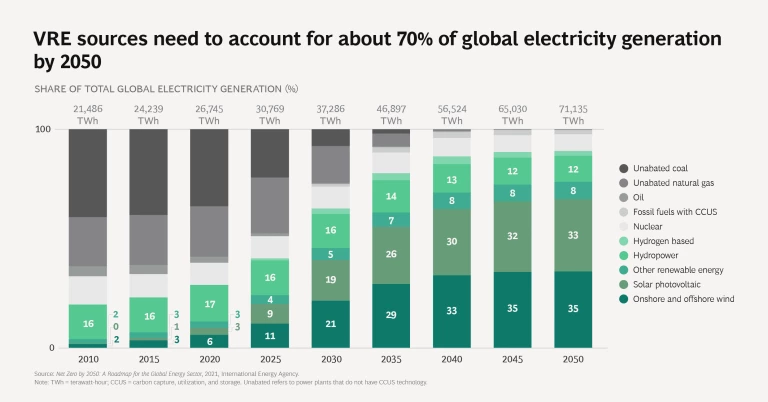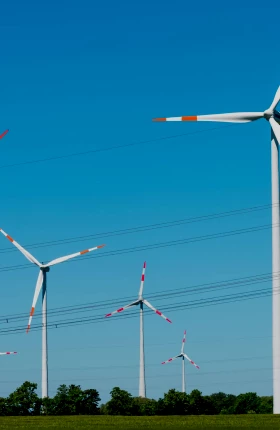As the share of variable renewable energy climbs, tackling four challenges will become an urgent task for system operators and designers.
Renewable energy will need to make up the majority of global electricity generation by 2050—as much as 90%, according to the International Energy Agency—for the world to achieve net-zero emissions by then.
Renewable energy’s share stood at 29% in 2020, which suggests that it would have to triple by 2050—no easy feat since, as the IEA notes, the total amount of electricity generated will have to jump by more than two-and-a-half times to achieve global decarbonization ambitions.
Most of the electricity that is generated from renewable energy will have to come from variable sources because of constraints on the availability of dispatchable renewable generators (such as hydropower, geothermal, and biofuel plants). In 2020, sources of variable renewable energy (VRE) accounted for 9% of global generation. According to the IEA’s net-zero roadmap, however, they will need to represent close to 70% by 2050.
Generating electricity from VRE sources—such as solar photovoltaic systems and onshore and offshore wind turbines—is different from producing power using conventional generators. By definition, VRE depends on the sun shining or the wind blowing. And because VRE is subject to weather conditions, it is uncertain and challenging to predict perfectly. VRE is also distributed (generators are smaller and less centralized), and it relies on inverters (power electronic devices that change the direct current from solar panels or wind turbines into alternating current for electricity grids). For electricity system operators and designers that are integrating VRE sources at scale, these characteristics lead to significant challenges in four areas:
- Resource adequacy
- Network adequacy
- Frequency stability
- Voltage stability
In places that generate a lot of electricity from VRE—for example, Australia, California, Denmark, Germany, and Texas—we have already seen greater system instability arising from issues in these areas.
As the share of VRE rises, tackling these four challenges will become increasingly urgent for system operators and designers. To ensure that electricity grids are reliable, operators will need to weigh a variety of measures. These include investing in new grid infrastructure and tools, retaining more dispatchable generators, increasing storage and demand-side flexibility, and implementing the right set of incentives to ensure that various stakeholders act to address the challenges.
This article is the second in a series that explores changes to our electricity and broader energy systems—and the implications for energy consumers and governments—that will arise from the massive increase in variable renewable energy needed to achieve global decarbonization ambitions.
The authors thank Sander Claeys, Marie-Charlotte Cosyns, Charlotte De Causmaecker, Lavinia Rubinacci, and Konstantinos Spiliotis for their contributions to this publication.


























